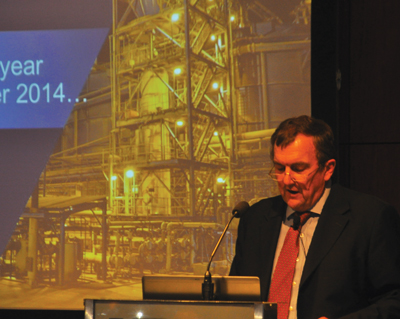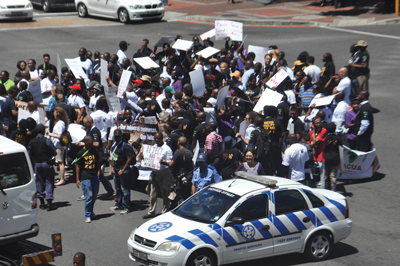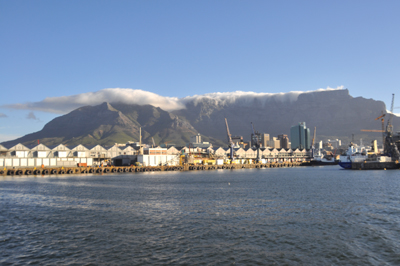Energy availability, financial resources and CSR receive attention
By Gavin du Venage, South African Editor
 |
| Randgold Resources’ Mark Bristow told attendees Africa’s mining sector is in a ‘sorry state’ from mostly self-inflicted problems and lack of long-term planning. |
It’s becoming a recurring theme for the annual Investing in African Mining Indaba to begin under a cloud of foreboding. Last year, it was talk of mass strikes; the year before that, nationalization. In 2015, region-wide power crises and dismal commodity prices dominated.
This did not, however, stop the miners and bankers from turning up in droves. Jonathan Moore, vice president and managing director of Mining Indaba, said this year’s attendance was pretty much the same as 2014. “We have around 8,000 attendees,” he said in an interview. “We may not have as many exhibitors, but a lot of companies are here as attendees, if not actually taking a booth.”
He noted that this would be a tough year for corporate and financing activity, as resource companies scrabbled for capital from increasingly gun-shy investors. South Africa’s official figures show mining production contracted 1.5% last year, following a marathon strike in the platinum sector. Production would no doubt be under further pressure as the country’s power utility, Eskom, introduced rolling blackouts, a situation that is expected to persist into 2018.
The country’s new Mines Minister Ngoako Ramatlhodi picked up on the power crisis in his debut Indaba speech. “Government understands the importance of infrastructure in the development of the economy,” Ramatlhodi said. “We thus committed more than 1 trillion rand ($85-billion) in infrastructure development.”
The electricity crisis stems from the inability of Eskom to complete its giant Medupi power station, which was scheduled to add 4,800 megawatts (MW) to the grid this year. The plant is now three years behind schedule, and as a result, power cuts are becoming an almost daily occurrence.
The government was paying particular attention to energy, he noted, “as we acknowledge the reality that there is no mining without energy.”
Ramatlhodi said government was augmenting cash-strapped Eskom capacity to attain a long-term sustainable financial solution and encouraging renewables such as wind and solar farms. The country is also in talks with nuclear vendors to build up to five plants with a total capacity of 9,600 MW.
He added that the Great Inga project, a hydro scheme on the Congo River that would be twice as big as China’s Three Gorges should it came to pass, was South Africa’s “crowning glory.” South Africa was the major sponsor of the dam in the Democratic Republic of Congo and had signed an off-take contract for 2,500 MW annually by 2023.
Many observers, however, suggest that the scheme is unlikely to commence anytime soon, and the day after the minister’s speech, the influential Johannesburg publication Business Day described the minister’s comments on the issue as “bizarre.”
Ramatlhodi also tried to put a cheerful spin on the likelihood of some of the country’s largest mining houses drastically cutting back their presence in the country. BHP Billiton said it wants to hive off its South African operations into a separate company; Anglo American wants to sell two of its platinum mines and three of its coal mines. Other South African assets will also probably have a “for sale” sign hung on their door in coming months.
The minister said the government was considering buying these assets and placing them with a “national champion.” This would be community based, he said, with an executive selected on the basis that they would “stay in for a very long time.” This was a clear nod to critics of current black empowerment policies, which have seen a small circle of politically connected businessmen circulate among mining companies, garnering oligarch-like wealth along the way.
 |
| Demonstrators outside the Indaba venue seek to highlight the need for community participation. |
The era for individual empowerment in the mining industry is over, said Andrew Lane, Africa energy and resources leader for Deloitte. “The mood at the Mining Indaba is generally less adversarial,” he noted. “The reference to a national champion is intriguing,” he said. “Will this be the role of the state-owned mining company? Does a national champion have to be run by government to be successful? Governments of resource-rich countries around the world grapple with the issue of resource nationalism.”
Finally, Ramatlhodi told the gathering that he would put a stop to lengthy strikes, such as the five-monthlong violence-prone work stoppage that crippled platinum production last year. “We’ll arrest and charge lawbreakers and send them to jail,” Ramatlhodi said. “There will be no turning back on that.”
The audience though, was skeptical that he would manage to follow through. The ruling African National Congress remains highly dependent on union support and has historically shown little stomach for taking them on.
REALITY CHECK
If the urgency of South Africa’s predicament was not conveyed by the minister, economist Dambisa Moyo was less artful in her presentation. “A country needs a minimum of 7% gross domestic product growth a year to make a dent in poverty; South Africa is struggling along with 1.4%,” she said. Moyo noted that as the world’s top economies struggled to raise growth, the fallout would inevitably hurt emerging markets, particularly those dependent on resources. The result, she said, would be civil unrest and a challenge to emerging democracies.
“At low income distribution, democracies don’t last,” Moyo said. “It takes $6,000 per capita income average for democracy to survive. The vast majority of emerging markets struggle to reach that number.”
Even the Chinese, the great hope of the African resources sector, were faltering. Jim O’Neill, former chief economist at Goldman Sachs and the man who coined the term “BRIC” to classify Brazil, Russia, India and China, said the era of double digit growth for the world’s largest economy was over.
For the rest of the decade, O’Neill said, Chinese growth would not top 7.5%. A bright spot, though, was that for the first time, the Chinese were consuming more than they were saving. “We are looking at a completely different China from the one we thought we knew from the previous decade,” O’Neill said.
China was aware, he said, that the financial crisis of 2008 was caused as much by the Chinese saving too much as it was by the Americans saving too little. This trend was reversing now as the U.S. was saving more while China was saving less. “Beijing wants people to spend more so that the country’s accumulated wealth can be shared more widely,” O’Neill said.
Former British Prime Minister Tony Blair, for his part, gave an upbeat address on Africa’s prospects without saying much of substance. His talk was peppered with Downing Street anecdotes and memes such as “the world’s fastest growing economies are in Africa.”
He did touch on the fact that some of the continent’s headline basket cases such as Rwanda and Ethiopia were now demonstrably on the path to a better future. “These countries that were the poster children for poverty are now very interesting to investors,” Blair said.
 |
| Equipment suppliers—and mining contractors—showcase their products and services at the annual show. |
BANKING ON IT
If there was one encouraging sign to come from the Indaba—which bills itself as Africa’s largest investment event—it was that the moneymen were there in force. As bankers do, they were looking for the best angle to pursue.
“There’s a shift away from traditional minerals such as gold and iron, to specialist minerals such as graphite and rare earths,” said Nivaash Singh, head of mining and international resource finance at Nedbank Capital, in an interview on the sidelines of the conference. “This is a huge learning curve for us as bankers.”
He conceded that the immediate outlook was grim, but that sooner or later the cycle would reverse back into a boom. Until then, investors would have to navigate the hazards of falling commodity prices, ebola and terrorism, which Singh said, most analysts had miscalculated the impact of.
Singh was also sanguine over South Africa’s power troubles. “For South Africa, it’s a short-term crisis, but for the rest of Africa it’s a long-term problem,” Singh said.
It was also time for juniors to adjust their business model. Singh said the practice of “flipping” exploration projects to the majors is dead in the water. Finance for projects was there, but bankers were only looking at those whose management were intending on taking them to production. This would mean securing off-take agreements and often as not, beginning small.
“We prefer a modular approach, where a project begins a modest operation that generates money soon,” Singh said. “Expansion can always be carried out later,” he concluded.
If, by now, the optimists had not fled to one of the off-site cocktail events to find solace, there were more pessimistic tidings to come in the form of gloomy commodity outlooks.
“Iron ore prices may be languishing at their lowest level for nearly six years, but it remains difficult to make a positive case for prices in the short term,” said Roger Emslie, principal metals and mining consultant for Wood Mackenzie. “Chinese steel mills have cut production in recent weeks due to a combination of weak demand and planned maintenance and this is feeding through directly to iron ore requirements.”
He said he expected the glut in Chinese steel production to get worse before it gets better and that steel mills will not restock in a falling or stagnant market. Outside of China, the picture was similarly uninspiring due to a combination of seasonal and structural factors. “Other than the Middle East and India, none of the major iron ore importers have shown any meaningful improvement in demand, a situation that is unlikely to change in the short term,” Emslie said.
MOVING ON
Miners are not just curling up on the floor, however. Companies are evolving strategies that, for some at least, could see a fundamental change of direction. Chris Griffith, CEO of Anglo Platinum, said the company was still recovering from last year’s bruising strike in a sector where “poor capital allocation had led to brutal overproduction.”
 |
| Attendance at Indaba 2015, held in Cape Town, South Africa (pictured here) was estimated at 8,000. |
Griffith pointed out that, up to now, mining companies had spent relatively little on research and development. “It’s quite extraordinary that global mining spends 80% less than the oil industry,” Griffith said.
Mining he added, needed to move 20 years in the next five if it was to survive. Amplats was, therefore, moving away from labor-intensive mining that requires high capital expenditure and large amounts of energy.
Instead, the company was developing new technologies that would allow mines to use fewer people but in a higher skilled capacity. Already 10% of operations at the Bathopele mine west of Johannesburg was automated and human rock drillers obsolete.
Remote-controlled drill rigs and haulers were being tested and would soon become standard across operations. Ultra-low haul dumpers were being developed in conjunction with Atlas Copco, Griffith said. Lasers were also being tested as a means to soften rock, technology that could eventually eliminate drilling and blasting.
“We are on a huge cusp of explosion and drilling technology that will transform the industry,” Griffith said.
IRRESPONSIBLE MINERS
It fell to Randgold Resources CEO Mark Bristow to offer some harsh words to the mining industry, which he said had brought many of its problems down on itself. Randgold is one of the few miners to raise its dividend while holding no debt in the current environment.
Bristow said the sector is handicapped by an irresponsible short-term culture, an unfortunate legacy of the boom years. “The harsh truth of the matter is that the mining sector has inflicted debt, impairments and write-downs on itself without making provision for its own long-term future, and is in a sorry state,” Bristow said.
At the same time, African governments were also too eager to squeeze producers. “In fact, even at current prices, and this applies to gold in particular, the industry is not viable without a major reinvention,” Bristow said. “Yet, even now, almost all Africa’s mining countries are revising their mining codes and regulations to increase their share of the miners’ revenues. To put it bluntly, they are demanding more money from an industry that is basically insolvent.”
African governments and the communities they represent are an ongoing theme in resource circles. Although official delegations representing various national mining chambers, as well as individual governments, are regulars at the Indaba, communities themselves seldom are. For this reason, a parallel event, the Alternative Mining Indaba, has become a small but vocal attempt to remind the industry that it’s not all about money and minerals.
“They come and build a mine in our lands then go when the wealth is finished, leaving us with the mess,” said a demonstrator who would only identify himself as Kobus outside the venue convention center. “They make deals with each other but nobody talks to us.”









